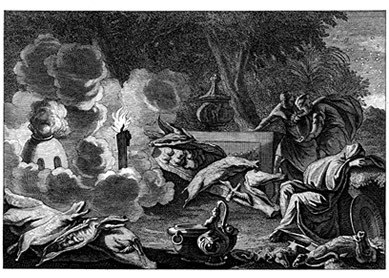Today, Yom Kippur is the most solemn day of the Jewish calendar. But how did it develop from a day centered around cleansing the wilderness tabernacle to a day focused on personal atonement?
Is “the Day of Atonement” a good translation of the Hebrew Yom Kippur?
The fall holy day celebrated on the tenth day of the seventh month is called twice in the Hebrew Bible, Yom Hakippurim (Lev 23:27; Lev 25:9), and medieval Jewish texts often call it Yom Kippur. (Kippur is the singular of kippurim.) The conventional translation “atonement” for kippurim comes from the Septuagint, the ancient Jewish Bible translation into Greek, and from Jerome’s Latin translation (the Vulgate), which renders it as “expiationum,” expiation, which usually refers to the process by which an individual performs some actions that cause sins to be forgiven. The Hebrew word, however, does not refer to atonement or expiation in this sense.
The main biblical text that describes the Yom Kippur ritual is Lev 16, which uses Hebrew terms related to kippur sixteen times, most often in reference to parts of the tabernacle, the pre-temple sanctuary imagined to have accompanied the Israelites in their forty-year wilderness journey. It is the tabernacle, or parts of it, such as the sacrificial altar or the holy of holies—the innermost part of the tabernacle—which is kippur-ed according to most verses of the chapter. In other words, the altar absorbs certain sins of the Israelites, and the main function of Yom Kippur is to cleanse these sins by using the blood of a purification offering (sometimes called a “sin offering”) as a type of ritual detergent. Leviticus 16 describes in detail this bloody ritual, at which the high priest Aaron or his descendants officiate; it makes the tabernacle (or later temple) ritually clean, and thus God is willing to reside there among Israel. The biblical term yom kippurim is thus best translated as “the day of purgation,” and specifically refers to the purgation or cleansing of sins from the tabernacle or temple. This festival only appears in Priestly texts that focus on the tabernacle or temple, such as Lev 16 and Lev 23; it is absent from other biblical calendrical texts (e.g., Exod 23 and Deut 16) that have a more agricultural focus.
Leviticus 16 describes other rituals as well, including a scapegoat that carries away the sins of the Israelites. Thus, the chapter is broadly concerned with cleansing sin but not with repentance, which would become the main theme of the day’s activities after the destruction of the Second Temple in 70 CE. In such ritual practices, the significance of repentance is emphasized through the liturgical reading of the book of Jonah, whose main theme is the efficacy of sincere repentance. Most of the other activities now associated with Yom Kippur, such as fasting, are based on the interpretation of the phrase “you shall deny yourselves,” which appears in various biblical texts about Yom Kippur (e.g., Lev 16:29); rituals of self-denial are meant to call God’s attention and sympathy.
Why is Yom Kippur important in the New Testament?
The rituals surrounding Yom Kippur play a major role in the New Testament, in which a number of texts implicitly view Jesus as a Yom Kippur offering. This association is found in a wide variety of texts: in the gospels (Matt 27:15-26), in Paul (Rom 3:24-26; Gal 3-4), and in texts sometimes attributed to Paul in Christian tradition (Heb 9). The supersessionist author of Hebrews emphasizes how Jesus is more perfect than the priests from the family of Aaron who performed the Yom Kippur rituals in Lev 16, and thus the offering of Christ, and his blood, is more effective than the sacrifice described in the “Old” Testament:
9:11 But when Christ came as a high priest of the good things that have come, then through the greater and perfect tent (not made with hands, that is, not of this creation), 12 he entered once for all into the Holy Place, not with the blood of goats and calves, but with his own blood, thus obtaining eternal redemption. 13 For if the blood of goats and bulls, with the sprinkling of the ashes of a heifer, sanctifies those who have been defiled so that their flesh is purified, 14 how much more will the blood of Christ, who through the eternal Spirit offered himself without blemish to God, purify our conscience from dead works to worship the living God!
This is one of many cases that shows the manner in which the religion that would develop into Christianity is deeply indebted to the Hebrew Bible, which the early Christ-believing community interpreted in novel ways.




